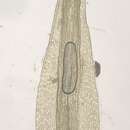Comments
provided by eFloras
Rhizoidal tubers, consisting of swollen rhizoidal cells and arising laterally from axial rhizoids, are known for Ditrichum lineare only from Asia (T. Matsui et al. 1985; Matsui and Z. Iwatsuki 1990). This species is very similar in appearance to D. pusillum but is distinguished by the rectangular cells of the sheathing leaf base. The leaf margins of North American specimens of D. lineare are entire and plane or rarely only weakly recurved, irregularly 2-stratose but not noticeably thickened, and the lamina cells are elongate rectangular to linear. The leaf margins in D. pusillum are irregularly thickened, serrulate, more strongly recurved, and the lamina cells generally subquadrate to short-rectangular. Ditrichum lineare also has a subula shorter than the sheathing base, which is unusual in the genus. This macroscopic feature is sometimes used to distinguish it from the closely related D. pusillum, which has a subula longer than the sheathing base, typical of many species in the genus (R. R. Ireland 1982).
- license
- cc-by-nc-sa-3.0
- copyright
- Missouri Botanical Garden, 4344 Shaw Boulevard, St. Louis, MO, 63110 USA
Description
provided by eFloras
Plants in loose to dense tufts, yellowish green. Stems to 1(-1.5) cm, simple or with few branches. Leaves to 2 mm, erect and ± ap-pressed to the stem, oblong-lanceolate, widest at or slightly just proximal to the middle, tapering gradually to a rather blunt apex, lamina 1-stratose except on margins; margins subentire, plane to narrowly recurved, ± erect near the apex, irregularly 2-stratose in the distal half of the leaf; costa percurrent, broad, occupying about 1/3 width of the leaf base, in section with a weakly developed stereid band on abaxial side of guide cells; cells of proximal part of lamina rectangular, thin to moderately thick-walled, becoming slightly shorter and narrower towards the leaf apex. Specialized asexual reproduction by rhizoidal tubers. Sexual condition dioicous; perichaetial leaves with a sheathing base, abruptly narrowed to a short subula about as long as the base or shorter. Seta yellowish, brown to orange-brown with age, to 2.5 cm or sometimes longer, erect. Capsule erect and symmetric or slightly curved, brown to reddish brown, narrowly ellipsoid to cylindric, 1-2 mm, smooth or indistinctly furrowed when dry; operculum obliquely conic-rostrate, blunt, 0.3-0.7 mm; peristome divided by perforations into 2 ± adhering divisions, 200-220 µm, finely papillose. Spores 13-16 µm, appearing smooth or very finely verrucose, brown.
- license
- cc-by-nc-sa-3.0
- copyright
- Missouri Botanical Garden, 4344 Shaw Boulevard, St. Louis, MO, 63110 USA
Synonym
provided by eFloras
Didymodon linearis Swartz, Adnot. Bot., 100. 1829; Ditrichum vaginans (Sullivant) Hampe; Trichostomum vaginans Sullivant
- license
- cc-by-nc-sa-3.0
- copyright
- Missouri Botanical Garden, 4344 Shaw Boulevard, St. Louis, MO, 63110 USA

